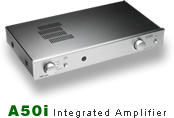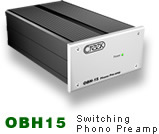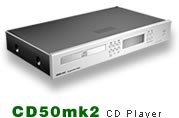Three from Creek: Creek CD50 MK2 CD Player, Creek A50iR Integrated Amplifier and Creek OBH 15 Phono Preamplifier
| Three from Creek: Creek CD50 MK2 CD Player, Creek A50iR Integrated Amplifier and Creek OBH 15 Phono Preamplifier |
|
Three New Affordable Products that get the Music Right |
|
Paul Szabady |

May 2004
A very disquieting fact emerged during my 25 years in the US audio trade: most passionate music lovers simply cannot afford what have become known as High End products. The situation has gotten steadily worse since the 1980’s, when the concept of the High End became established. Unfortunately, the term no longer reliably refers to the highest of performance, but simply to the highest of price. Is there any reason to assume that those who can easily afford High End gear – say lawyers, surgeons, stock market bandits, CEO’s and drug dealers – have any kind of musical sensitivity that would lead to appreciation of ultra-fidelity, ultra-expensive components?
Even more unfortunately, most non-audiophiles (particularly women) understand High End sound as loud, piercing and obnoxious and that it will make their LPs and CD’s sound worse. This attitude is the complete reverse of the customer mindset when I began working in audio in 1972; everyone then wanted their music to sound better and was willing to pursue high performance products to do so. The current monopolization of the market by Super Store chains has dumbed-down available products to the point where illusory discounts and jive rule, and music is altogether absent. What’s a music lover to do?
The UK has, by contrast, a firmly established tradition of indigenous companies offering extremely musical products at prices that any willing music lover can afford. So strong is that tradition that the big sleazy multinational firms are forced to offer UK-dedicated products that are actually designed around producing music in order to have half a chance in the UK market. One of the central forces in establishing that music-first tradition is Creek Audio, eponymously named and still run by Mike Creek. The company has a strong reputation of offering musically moving products at real-world prices. Creek now also owns Epos loudspeakers, with which it has long been partnered. My experience with them dates back four product generations; the 3 new Creek products reviewed here strike me as the company’s best yet. Music lovers can rejoice.
 The A50i integrated amplifier continues Creek’s tradition of exemplary musical performance at non-insane prices. Integrated amps have always been the nucleus of UK audio systems and there are numerous reasons for their dominance. One is simple value, coupled with a high Non-Screw-Up-ability Factor. One saves the price and hassle of choosing an interconnect, and also the possibility of mismatching the preamp to the power amp when using items from different manufacturers. The only trade-off is the need to use longer speaker cables in some installations.
The A50i integrated amplifier continues Creek’s tradition of exemplary musical performance at non-insane prices. Integrated amps have always been the nucleus of UK audio systems and there are numerous reasons for their dominance. One is simple value, coupled with a high Non-Screw-Up-ability Factor. One saves the price and hassle of choosing an interconnect, and also the possibility of mismatching the preamp to the power amp when using items from different manufacturers. The only trade-off is the need to use longer speaker cables in some installations.
The preamp section of the A50i is passive, higher gain in the 60 watt per channel amplifier making up the difference. Like many of the best UK integrated amps, design is modular. The A50i offers 4 line level inputs (one of which can be configured for phono preamplification) plus a tape monitor. Modules for moving magnet phono and moving coiling phono cost $80 and $100 respectively; Special Edition (SE) versions of these two modules are a $50 premium each. An active preamp gain stage can be added for $80. The A50iR adds remote control for an additional $200. My review sample was the A50iR without any of the internal phono modules installed in my review sample, as I was also reviewing the Creek OBH15 outboard phono preamp. Appearance and features of all 3 products is austere and low-key in the traditional UK way. Also following that purist tradition is the A50i’s lack of tone controls, a balance knob, or a mono switch.
 The OBH 15 includes the OBH 2 outboard power supply and allows for both moving magnet and moving coil playback. Analogue enthusiasts can run both types of cartridges simultaneously as there are two set of phono inputs: a push button on the rear switches operation. (Make sure you turn the volume off when making the switch.) Phono performance of the OBH 15 is roughly equivalent to the SE phono modules, altered slightly by the dedicated power supply.
The OBH 15 includes the OBH 2 outboard power supply and allows for both moving magnet and moving coil playback. Analogue enthusiasts can run both types of cartridges simultaneously as there are two set of phono inputs: a push button on the rear switches operation. (Make sure you turn the volume off when making the switch.) Phono performance of the OBH 15 is roughly equivalent to the SE phono modules, altered slightly by the dedicated power supply.
I ran 6 turntables (thus my not including one of Music Hall’s turntables in this review) with 8 different cartridges and 5 sets of loudspeakers with this combination. Common to all was a sonically seamless and musically coherent performance that immediately shifted attention to the quality of the music being performed rather than on the components doing the reproduction. Tonal quality was equally coherent, with no part of the frequency spectrum being spotlighted or slighted. Bandwidth was wide with no sense of frequency truncation at either frequency extreme. Drive, dynamic contrast/shading, rhythm, and phrasing were top drawer, leading to deep musical involvement with all types of music: no need to restrict one’s listening to the amplification’s limitations. The polyrhythmic boogie of Little Feat was handled as adroitly as Schubert’s Quintet in C; Mozart danced as well as James Brown; solo instruments shone as clearly as full orchestras. While Creek’s generational predecessors to the A50iR struck me as slightly bright (4040/4140 series) or a bit too polite (4330), the A50iR hit the Goldilockian ideal of being “Just right.”
Resolution is very high, leading to convincing sonic portraits in believable acoustic landscapes. The amp continues the Creek tradition of being able to drive varying and difficult speaker loads with aplomb. The speakers I used included 4-ohm loads (Infinity Qb), the capacitive load of electrostatics (Sound Lab Dynastats), the reticent and low sensitivity Spendor 2040, and various revealing tweeters that can spotlight amplifier flaws. A natural match was the Epos M15.2; not very surprising really, considering that Creek owns Epos and that US importer Music Hall distributes both. The A50iR was unruffled by any of these combinations, maintaining its drive and confidence while still delivering the music.
The OBH 15 phono preamp was of the same sonic and musical fabric as the A50iR and, as a $450 outboard phono section that offers both MM and MC inputs and permits running two turntables, is a supreme bargain. Both inputs were excellent musically and sonically; my only purist quibble being to make sure that one’s MC cartridge works optimally into the OBH 15’s MC cartridge load of 1000 ohms, as it is not adjustable.
 The CD50 Mk2 CD player was as much an over-achiever as the amp and phono section: so much so that I gave it my Most Wanted Component of 2004 award. Other than CD’s historical inability to reproduce the tonality of acoustic instruments identifiably, its homogenization of subtle dynamic shifts, its turgid and a-rhythmic way with pulse, tempo, phrasing and rhythm, its a-musical somnolence and anti-musical artificiality, its eyeball-warping print size, and its “1984”-ish insistence that a 2-cent plastic case is in fact a ‘jewel box,’ I’ve been a big fan of the Perfect Sound Forever format. Things change. The CD50 Mk 2 is the first reasonably priced CD player that I actually want to own. More importantly it’s the first reasonably priced CD player I actually want to listen to music on. It produces music in the way that previously was the sole provenance of LP. I had despaired of CD ever being this musically convincing and exciting.
The CD50 Mk2 CD player was as much an over-achiever as the amp and phono section: so much so that I gave it my Most Wanted Component of 2004 award. Other than CD’s historical inability to reproduce the tonality of acoustic instruments identifiably, its homogenization of subtle dynamic shifts, its turgid and a-rhythmic way with pulse, tempo, phrasing and rhythm, its a-musical somnolence and anti-musical artificiality, its eyeball-warping print size, and its “1984”-ish insistence that a 2-cent plastic case is in fact a ‘jewel box,’ I’ve been a big fan of the Perfect Sound Forever format. Things change. The CD50 Mk 2 is the first reasonably priced CD player that I actually want to own. More importantly it’s the first reasonably priced CD player I actually want to listen to music on. It produces music in the way that previously was the sole provenance of LP. I had despaired of CD ever being this musically convincing and exciting.
Convincing it is, both musically and sonically. The CD 50 Mk2 tracks volume changes unusually well, leading to fine articulation of dynamic contrast within a music line or rhythm. Beginnings and ends of notes were very well done, ending a long-standing CD flaw. Musical devices are well portrayed, leading to superb dynamic articulation, phrasing, and tension and release. Rhythm and drive are particularly strong, an area where CD has never convinced me before. To be applauded is the CD50 Mk 2’s refusal to dumb-down the signal to render it listenable; this is a genuinely high-resolution CD player, a phrase I’d long believed an oxymoron. Whether it achieves this through successful incorporation of new chip technology, intelligent power supply design, or by bolting a fairy to the player’s innards to spread enchanting fairy dust on the signal is immaterial to me. It works. It makes music, exciting music.
Experimenting with various state-of-the-art isolation devices under the three Creek products yielded no major musical improvement, leading to the conclusion that Creek’s designs are well thought out on the mechanical and vibratory level also
Three thumbs-up for these three excellent new Creek products. Although not chain store cheap, their high musical performance makes them bargains, especially in comparison to their many musically turgid High End (i.e. high-priced) competitors. Any serious music lover could buy these and never look back.
| Specifications
CD50 Mk 2 Single-play CD player – Price: $1495. A50iR – 60 watt/channel integrated amplifier. Price; $995, ($795 without remote control). OBH 15 – MM/MC Phono preamplifier with outboard OBH 2 power supply.Price: $450. |
| Address: Manufacturer: Creek Audio Ltd 12 Avebury Court Mark Road Hemel Hempstead HP2 7TA England Tel: +44 (0)1442 260 146 Fax: +44 (0)1442 243766 Website: http://www.creekaudio.com Email: info@creekaudio.com US Distributor: MUSIC HALL |
![]()
Stereo Times Masthead
Publisher/Founder
Clement Perry
Editor
Dave Thomas
Senior Editors
Frank Alles, Mike Girardi, Russell Lichter, Terry London, Moreno Mitchell, Paul Szabady, Bill Wells, Mike Wright, and Stephen Yan,
Current Contributors
David Abramson, Tim Barrall, Dave Allison, Ron Cook, Lewis Dardick, John Hoffman, Dan Secula, Don Shaulis, Greg Simmons, Eric Teh, Greg Voth, Richard Willie, Ed Van Winkle, Rob Dockery, Richard Doron, and Daveed Turek
Site Management Clement Perry
Ad Designer: Martin Perry





Be the first to comment on: Three from Creek: Creek CD50 MK2 CD Player, Creek A50iR Integrated Amplifier and Creek OBH 15 Phono Preamplifier